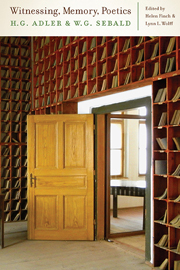Book contents
- Frontmatter
- Contents
- Acknowledgments
- List of Abbreviations
- Introduction: The Adler-Sebald Intertextual Relationship as Paradigm for Intergenerational Literary Testimony
- Part I Intertexts in Context
- Part II Witnessing Trauma and the Poetics of Witnessing
- Part III Memory, Memorialization and the Re-Presentation of History
- 7 Memory, Witness, and the (Holocaust) Museum in H. G. Adler and W. G. Sebald
- 8 History, Emotions, Literature: The Representation of Theresienstadt in H. G. Adler's Theresienstadt 1941–1945: Das Antlitz einer Zwangsgemeinschaft and W. G. Sebald's Austerlitz
- Part IV Literary Legacies and Networks
- Afterword
- Bibliography
- Notes on the Contributors
- Index
8 - History, Emotions, Literature: The Representation of Theresienstadt in H. G. Adler's Theresienstadt 1941–1945: Das Antlitz einer Zwangsgemeinschaft and W. G. Sebald's Austerlitz
from Part III - Memory, Memorialization and the Re-Presentation of History
Published online by Cambridge University Press: 05 October 2014
- Frontmatter
- Contents
- Acknowledgments
- List of Abbreviations
- Introduction: The Adler-Sebald Intertextual Relationship as Paradigm for Intergenerational Literary Testimony
- Part I Intertexts in Context
- Part II Witnessing Trauma and the Poetics of Witnessing
- Part III Memory, Memorialization and the Re-Presentation of History
- 7 Memory, Witness, and the (Holocaust) Museum in H. G. Adler and W. G. Sebald
- 8 History, Emotions, Literature: The Representation of Theresienstadt in H. G. Adler's Theresienstadt 1941–1945: Das Antlitz einer Zwangsgemeinschaft and W. G. Sebald's Austerlitz
- Part IV Literary Legacies and Networks
- Afterword
- Bibliography
- Notes on the Contributors
- Index
Summary
In a text about the genesis of his bookTheresienstadt 1941–1945, H. G. Adler states that he attempted, following the paradigm set by ethnologists, to observe the concentration camp “vorurteilsfrei und nüchtern” (impartially and soberly) while simultaneously taking into consideration his own position as a participant. According to Jeremy Adler, in his afterword to the 2005 reprint of Theresienstadt, H. G. Adler founded his method on the work of the ethnologist Bronislav Malinowsky. This method implies a “Doppelblick” (double gaze) that is at the same time both from inside and from outside. In making this connection, Jeremy Adler accentuates the distinctive feature of Theresienstadt: the book is not simply a presentation of documentary material. He further refers to the clarity and vividness of Adler's description, the merging of documentation and analysis, and the integration of statistics within the stream of the narrative. In 2009, François Ottmann emphasized that Adler expresses his involvement by means of his personal tone, his use of “all tonalities,” his particularly artistic literary descriptions using differentiated syntax, metaphors, leitmotifs, and elaborate imagery.
I would like to build upon to these observations here by stressing a particular aspect of Adler's “hybrid” text: the literary portrayal of his emotions, meaning his “view from inside.” This should not be understood as a disavowal of the historical significance of the book. The verbalization of emotions in a literary form is a part of Adler’s position as a witness, and it induces a particular process of understanding within the reader which could not have been achieved with a pure presentation of facts.
- Type
- Chapter
- Information
- Witnessing, Memory, PoeticsH. G. Adler and W. G. Sebald, pp. 180 - 198Publisher: Boydell & BrewerPrint publication year: 2014



